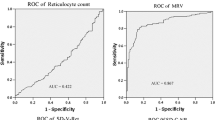Abstract
The Hl/H2 Technicon automated cell analyzer measures, in addition to the usual red blood cell (RBC) parameters, subpopulations of microcytic (M) and hypochromic (H) red blood cells. The M/H ratio may be useful in the differential diagnosis of iron-deficiency anemia (IDA) and β thalassemia minor (Thal). Thirty-three iron-deficient patients and 26 thalassemia patients were studied. The M/H ratio was found to be higher in thalassemia patients than in IDA patients. Using a cut-off point of 1.9 M/H ratio, the calculated discriminant efficiency was 88%. When glycerol lysis values were determined at 70 s as a cut-off point, the discriminant efficiency was slightly higher, at 91%. Thus, the combination of the M/H ratio and the glycerol lysis time (GLT) improves the discriminant efficiency and provides a good diagnostic tool to differentiate between the two microcytic-hypochromic anemias. The study suggests that the M/H ratio together with the GLT could serve as a useful screening tool, prior to the application of other more sophisticated methods.
Similar content being viewed by others
Author information
Authors and Affiliations
Additional information
Received: December 4, 1998 / Accepted: April 26, 1999
Rights and permissions
About this article
Cite this article
Yermiahu, T., Ben-Shalom, M., Porath, A. et al. Quantitative determinations of microcytic-hypochromic red blood cell population and glycerol permeability in iron-deficiency anemia and β thalassemia minor. Ann Hematol 78, 468–471 (1999). https://doi.org/10.1007/s002770050600
Issue Date:
DOI: https://doi.org/10.1007/s002770050600




